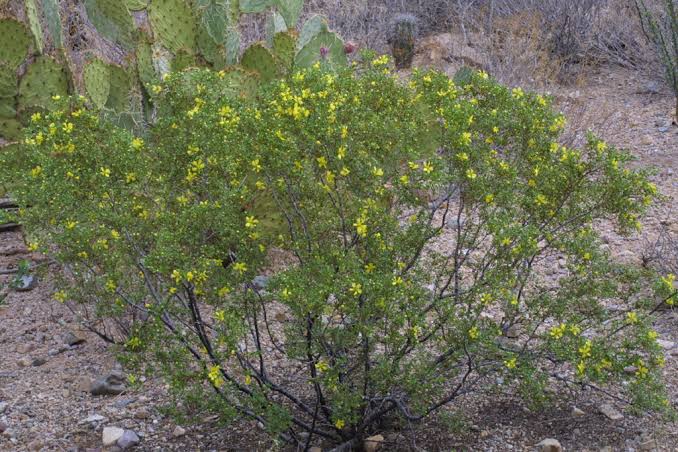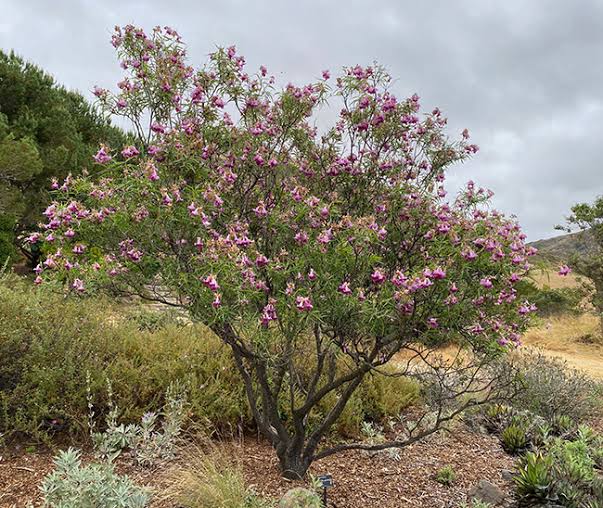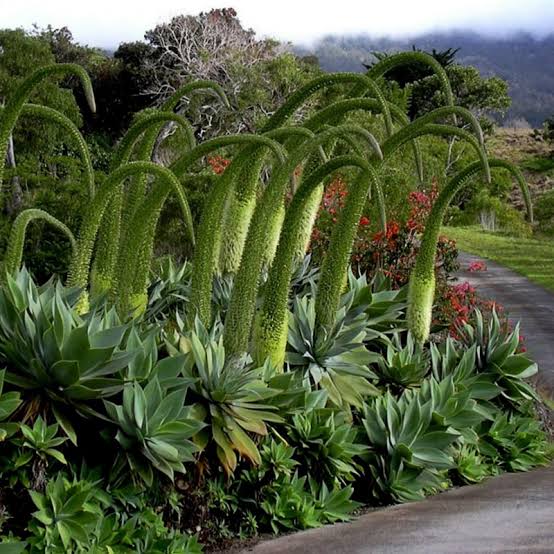Overview
A desert is generally a barren area of landscape where little precipitation occurs and consequently, living conditions are hostile for plants and animal life. Plants and animals that exist in the deserts have evolved to survive harsh conditions, scarce water and barren landscapes. Some desert habitat plants are short lived, only springing up to brighten the landscape only when the rain falls. Since desert conditions are so severe, the plants that live there need to have adaptations to compensate for lack of water. Many desert plants like cacti in Americas are able to absorb and store water, letting them survive long periods of drought whereas other plants like bushes conserve water by growing few leaves or by having large root systems to gather water. There are over 1000 desert plant species, most of which can be grown successfully in our home landscapes and gardens.
Types Of Desert Plants
1. Desert Lily (Hesperocallis undulate)

Desert lily also referred to as Ajo (garlic) lily by the Spanish because of the bulb’s flavor, has a deep bulb that sends up a stem in early spring that can be 1 to 4 feet high. The basal leaves are usually blue-green in color, long, strap-like and folded along the midline with wavy margins. The leaves have parallel veins typically monocots. The strap-like basal leaves are typically 8 to 20 inches long and 1.5 to 2.5 inches wide. The bulbs of desert lily can remain in the ground for several years, waiting for enough moisture to emerge.
Desert lilies have been observed to be in bloom in at least one year in the months of December to May. However, the actual bloom duration in a given year can be as short as two weeks in drier years. Desert lilies are found in the desert areas of southwest North America, in Northwestern Mexico, California and Sonoran desert habitats.
2. Wild Heliotrope (Heliotropium curassavicum)

Wild heliotrope is a variable annual herb growing decumbent to erect its branching or unbranched stem 15 to 80 centimeters in length. It is usually coated in soft or stiff glandular hairs which some people find foul-smelling when touched. The leaves are up to 10 to 15 centimeters long and are divided into several lobed leaflets, sometimes intricately. The flower of this plant is just about one centimeter long and is usually blue but can be white or varying shades of lavender or purple.
Wild heliotrope can reproduce by seed or can develop from shoots (rhizomes) and buds. Once the plant has established itself in an area, seed germination is of less importance and further growth is through the spreading of shoots and buds.
3. California poppy (Golden poppy)

The California poppy also referred to as golden poppy, California sunlight or cup of gold is a flowering species native to the United States and Mexico. It is generally considered as an annual plants and it typically blooms in the later summer months. It also has feathery gray-green foliage with four-petaled flowers, borne on stems 20 to 30 cm long. The flowers are usually pale yellow, orange or cream in the wild, but cultivated varieties are available in white, red and pink shades.
The plant can grow up to 1.5 feet in height and the plant’s flower maintains a strong bond with the sunlight, opening mid-morning and closing again in the evening, or at cloudy points during the day.
Also Read: Difference Between Agave And Aloe Vera
4. Sand Verbena (Wild Lantana)

The plant bears attractive neatly rounded heads of small, bright pink flowers. The individual flowers have no petals rather; they are composed of yellow bracts forming a trumpet-shaped calyx about the stamens. It bears a small, winded fruit. Short sticky hairs cover both the inch-long, oval, fleshy leaves and many-branched stems. This plant is native to the west coast of North America, from southern California to the Canada-United States border.
5. Saguaro Cactus (Carnegiea gigantea)

Saguaro is the largest cactus in the world. It is native to the Sonoran Desert in Arizona, the Mexican state of Sonora and the Whipple mountains and Imperial county areas of California. The saguaro cactus is a tree-like cactus which can grow up to 40 feet and 2 feet wide. It grows in tall columns and sprouts arms at the age of 75. The skin of the Saguaro is thick, waxy, light green and serrated into ridges. The ridges allow the cactus to expand like an accordion during rainy seasons to hold more water. Long, pointy spikes run down the ridges. The cactus has notably shallow roots; there is a main root that reaches up to 2-3 feet deep while the other roots only extended about a foot deep though they fan out far and wide.
The saguaro has bell-shaped flowers which are large, white and fragrant. They are typically 3 inches wide and bloom during the spring. The flowers are pollinated by bats, birds and insects that feed on the nectar. The fruit of the saguaro is cylindrical, scaly and about 2-3 inches long. The color changes from green to red and split open during the summer when ripe. The flesh of the fruit is bright, luscious red and contains many black seeds.
Also Read: Different Types of Euphorbia Plants
6. Cholla Cactus (Jumping cholla)

The chollas are native to the American Southwest in deserts and arid zones. They are composed of cylindrical stems arranged in segments and topped with inch long wicked spines. The spines are covered in a paper-like sheath which may be very colorful and attractive. The plant may be a creeper, shrub or tree. Sizes vary from 3 to 15 feet in height. Flowers are green or orange, depending upon species and bloom April through June.
7. Joshua Tree (Yucca Brevifolia)

Joshua tree, the largest of the yuccas, is a slow-growing, upright evergreen tree with a stout trunk, heavy branches and open, rounded canopy. Joshua trees are such a striking feature of the desert landscape that California even has a national park named for them.
Joshua tree usually has a single trunk and grows between 4 and 9 feet tall before branching. Branches end in clusters of spiky leaves and white, rounded flowers. The dead leaves hang on the plant covering the trunk and stems. In spring, the plant bears beautiful greenish-white flowers that are pollinated by a moth. Joshua trees are most commonly found in the Mojave Desert in the southwestern United States.
8. Mesquite Tree (Prosopis glandulosa)

The Mesquite tree is one of the most common trees of the Southwestern United States and parts of Mexico. It is a member of the legume family of plants which include peanuts, alfalfa, clover and beans. Mesquite trees may have one or multiple trunks with a multitude of branches with each assuming its own distinctive shape with thorns on their smaller branches. The leaves of this tree are narrow, pointed and are 2 to 3 inches long. The leaflets of this tree are bipinnate with a light green to blue hue that cast a light to deep shade, depending on the species.
Mesquite shed their leaves in the winter but will bloom from the spring into summer, bearing small frothy-looking clusters referred to as ‘’catkins’’ of tiny, five-petalled, pale green or yellowish flowers, which lure numerous pollinating insects. The flowers form a flat pod of beans 2 to 6 inches long. Mesquite trees have a long taproot that they use to absorb enough moisture from the deep underground to keep them alive. This characteristic enables the mesquite to survive in the desert.
9. Ocotillo (Fouquieria splendens)

Ocotillo grows throughout the Sonoran and Chihuahuan deserts from southern California to western Texas and south into Mexico. It is one of the easiest plants to identify in the desert. They are a large shrub with long cane-like unbranched spiny stems that grow from a short trunk. The stems of this plant are leafless most of the time. But, after a significant rainfall, the plant will be covered with clusters of narrow oval leaves about 2 inches long. The leaves remain on the plant until the soil dries out and then they fall off.
Ocotillos produce clusters of bright red flowers at their stem, which explain the plant’s name. Ocotillo means ‘’little torch’’ in Spanish. Plants bloom once in the spring from March through June depending on latitude then sporadically in response to rainfall during the summer.
10. Barrel Cactus (Compass Barrel)

Barrel cactus is native to the hot, dry North American desert. It has a cylindrical shape with vertical ribs or pleats. This type of cactus averagely measure more than 5 inches across and is less than 10 times as tall as it is wide. In the spring and summer, typically between April and September, brightly colored flowers (yellow/red) together with a yellow fruit emerge in a ring around the top of the stem.
11. Brittle Bush ( Encelia farinosa)

Brittle bush also referred to as incienso is a common desert shrub of northern Mexico and the Southwestern United States. Brittlebush gets its name from the plant’s characteristic behavior during the long, dry season of the deserts. Without water, the leaves drop, resulting in a cluster of barren branches that are easily broken or brittle. It grows up to 150 cm, the plant can reach height of 1 meter or more, but typically it is a smaller, compact, rounded bush.
The plant has a shallow taproot and numerous lateral roots that wait in the rocky desert soil for the next rainfall, before leafs emerging out once again and producing another burst of yellow flowers. The beautiful disk-shaped flowers rise several inches above the mounded cluster of leaves, giving the illusion of a layer of yellow color floating above gray-green plant.
12. Creosote Bush (Larrea tridentata)

The creosote bush also referred to as Larrea tridentata is a medium-sized evergreen shrub. It has small pointed green leaves with a waxy coating. It is usually less than 4 feet high, but can grow to 12-foot heights with abundant water. These leaves have adapted to conserve water and survive high temperatures. Inch-wide twisted, yellow petals bloom from February-August. After the Creosote blooms, the flower turns into a small white fuzzy fruit capsule that has 5 seeds. Creosote also secretes lots of waxy, resinous compounds which coat the leaves and to some extent the stems, making them appear lacquered.
13. Desert Purple Sage (Salvia dorrii)

Desert purple sage plant is a herbaceous perennial native to mountain areas in the western United States and northwestern Arizona. The green-gray leaves are narrow and lanced-shaped, are tapered at the base and rounded at the tip and have a smooth and round margin. The leaves of this shrub also have an intense but pleasant, mildly intoxicating minty aroma, with the scent released when the foliage is handled or crushed. The flower cluster is made up of spike-like clusters of numerous purple flowers that are bilateral.
14. Desert Willow Tree (Chilopsis linearis)

The desert willow tree also referred to as Bow willow is a native Texas tree or shrub that resembles the willow but isn’t actually part of the willow family. It is usually multi-trunked or low branching. Desert willow bark is smooth when young but develops rough fissures as it ages. White lenticels are noticeable on young bark or new growth. The flowers of this plant are dark pink or purple, often with white or yellow and purple streaks within the throat. The catapult-like flowers are borne in terminal racemes. The flowers are replaced by slender seedpods, 6-10 inches long, which remain dangling from the branches.
Also Read: Different Types of Aloe Vera Plants
15. Foxtail Agave (Lion’s tail)

Foxtail Agave is an evergreen succulent that forms large rosettes of attractive spineless leaves atop a stout stem that can grow up to 4 feet tall. The leaves are yellowish-green, blue-green to gray-green up to 28 inches long and up to 6 inches wide. The plant bears greenish-yellow flowers which give way to seed pods and many new plantlets. The rosette dies after flowing, but produces offsets around the base, often forming a colony of rosettes. After reaching the heights of 4-10 ft, it reflexes back towards the ground before arching up again like a fox tail.
False Sisal
The false sisal is a dramatic plant that grows five feet tall and wide. It will get much larger to about ten feet in frost-free locations. This agave is known for its bright green, long foliage that forms a tight, symmetrical rosette. Its fleshy leaves spread from the center of the plant and have small teeth along the margins. This plant produces many offsets for reproduction and propagation. Once in its lifetime, in late fall or early winter, it develops a ten- to twelve-foot flower stalk with many branches that support greenish-yellow flowers.
Twin-flowered Agave
This agave has dense, symmetrical foliage that grows in a rosette producing about a hundred or more erect, narrow, dark green leaves. The slender foliage grows to two to three feet tall with sharp edges and smooth margins on a flat, gray terminal spine. Some plants have whitish fibers growing along the leaf edges while others are fiber-less. Its flower stalk grows nine to twelve feet high with two flowering candelabra stems. The flowers are yellow with a reddish-purple coloring at the base. After the plant produces its majestic bloom at about ten years or so, it dies. This plant is more solitary and does not produce offsets like the other agave species.
Banana Yucca
The plant grows slowly to three to five feet tall and wide with large, strap-like, dark-green foliage that is stiff, erect, sharply pointed, and arranged spirally at the base of its stem. This plant also produces white fibers along its leaf margins that tend to curl on the plant. The fibers from its leaves can be soaked and used to make string or rope. In spring, the plant sends up tall flower stalks that come from a center whorl of leaves. The flowers are creamy white, bell-shaped and appear in thick clusters. Its young flowers are also edible and taste like asparagus. After flowering, the plant produces banana-like fruit that contains flat, black seeds. When the fruit is baked, is has a flavor similar to potatoes. Use it as a low-growing accent plant in desert landscapes or as a specimen planting. It can also be used as a focal plant in front of tall walls and foundations because of its picturesque form and growth habit.
Cape Aloe
Cape aloe reaches heights of ten feet or more, with a three- to four-foot spread. It forms a dense clump of bluish-green, fleshy, succulent leaves. The foliage is pointed at the tip and edged with sharp teeth along the margins. The fast-growing plant develops whorls of new foliage from its center. Older leaves dry and may leave a petticoat of growth on the stem. In late winter to early spring, it produces a large, candelabra-like, exquisite flower head. Each spike holds colorful orange to red or yellow blossoms. The blooms attract birds, bees, and butterflies.
Coastal Century Plant
The plant has attractive, fleshy, dark-green, leaves with sharp, serrated, brown teeth along its edges and a dark reddish-brown terminal spine. It forms a tight rosette and grows three feet tall and four to five feet wide. After ten years or more, it produces a tall, branching flower stalk that is seven to twelve feet tall or more, and resembles an asparagus. The flowering stem creates a greenish bloom with purple bracts in late summer through fall. This agave produces many offsets in its lifetime.
Other Desert Plants Include:
- Oleander
- Emu Bush
- Desert Spoon
- Organ pipe cactus
- Desert marigold
- Paddle plant
- Fox tail Agave
- Mexican Feather Grass
- Flaming Katy
- Ghost Plant
- Mojave Aster
- Prickly Pear Cactus
- Pencil Plant
- Livingstone
- Zebra Cactus
- Bunny Ear Cactus
- Winecup
- Queen Victoria Agave
- Moonstones
- Yellow Paloverde
- Soaptree Yucca
- Tumbleweed
- Date Palm
- Elephant Tree